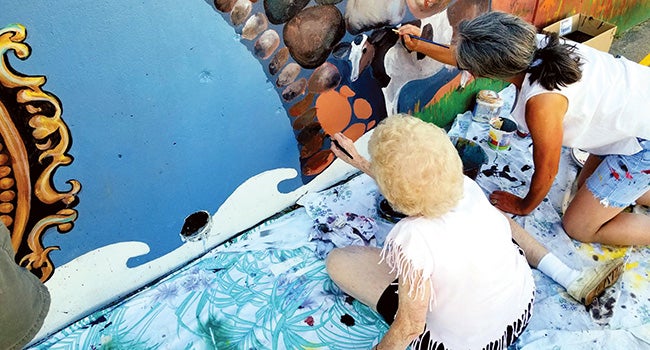Many hands making light work of Orphan Train mural
Published 11:01 am Tuesday, July 18, 2017

- Local volunteers have spent the last several weeks working with Cassopolis artist Ruth Andrews on the Dowagiac Orphan Train mural, located beneath the post office on Pennsylvania Avenue downtown. The work is expected to take place through August, with Andrews refining the painting before its public unveiling Oct. 7. (Submitted photo)
When organizers of the ongoing effort to transform a once ordinary downtown stone wall into a mural depicting the famous Orphan Train described the artwork as a community project, they meant it.
Throughout the last several weeks, dozens of Dowagiac residents have picked up a palette and paintbrush to contribute to the painting, which kicked off earlier this summer. Thanks to their handiwork, the painting is about half done, and work is expected to finish on schedule, said Ruth Andrews, the lead artist on the project.
“It has been a fun process,” Andrews said. “We have had a real variety of people come out to help paint. We have encountered some little problems here or there, but we always manage to solve them and move on to the next step.”
The mural, which is located on the concrete wall beneath the Dowagiac post office on Pennsylvania Avenue, is the centerpiece of the recent collaboration between the Cassopolis artist and others in the Dowagiac community to highlight the history of the Orphan Train, an orphan relocation program that ran from 1854 to 1929. The Grand Old City was the destination of the first train, which arrived in September 1854.
Andrews’ design for the mural is meant to showcase that fateful journey, starting from the children’s beginnings living on the streets of New York City, to the train ride itself, to futures the children faced after their arrival in Dowagiac — be it finding a new family or falling through the cracks once more.
To assist Andrews with painting, organizers with the project put out a call for volunteers earlier this year. Dozens responded, working alongside the artist in morning and evening shifts several times a week.
The talent pool has ranged from children to the elderly, from beginners who have never picked up a paint brush before to professionals who have spent practically their entire lives behind an easel, Andrews said. The artist assigns different parts of the mural to different artists, depending on their skill level, she said.
Among those who have pitched in this summer is Alli Farkas, a Dowagiac artist who specializes in watercolor and oil paintings. Farkas agreed to help paint after she was approached by Andrews earlier this summer, she said.
“She [Andrews] told me, ‘hey, I have this horse for you to paint,’” Farkas said, noting that one of her specialties is paining horse portraits.
While she has been an artist for as long as she can remember — the earliest work in her scrapbook she made when she was 5 — this is the first time that Farkas has worked on a mural. The process has been a learning process for her, as she had to make several adjustments to adapt to the changes between working on a course, uneven wall instead of a smooth paper canvas.
The work has also given her a chance to bond with other people passionate about art. Between rounds of intense work, she and the other volunteers share stories and jokes, and have developed a strong sense of camaraderie.
“It’s been really fun,” Farkas said. “The best part is that people are always stopping by to tell us how great it is that we are doing this and how great the mural looks. What more could you ask for?”
Andrews echoed this statement, adding that a local pastor stopped by one morning and asked for the volunteers to join him in prayer.
“The community has really embraced this project,” Andrews said. “It must be like how Dowagiac embraced the train itself. It’s a real lovely feeling.”
The volunteer painting project is expected to take place through August. After that phase of the work is finished, Andrews will spend September refining the mural before its planned grand reveal to the public during the Under the Harvest Moon Festival Oct. 7.
People may sign up to volunteer by calling the Dowagiac Area History Museum at (269) 783-2560 or by visiting dowagiacmuseum.info/orphan-train.
“Be fearless,” Farkas said. “We have got things that anyone can do. Come join the crew.”
The Orphan Train project is funded in part by the Michigan Humanities Council, an affiliate of the National Endowment for the Humanities, and local donors.





